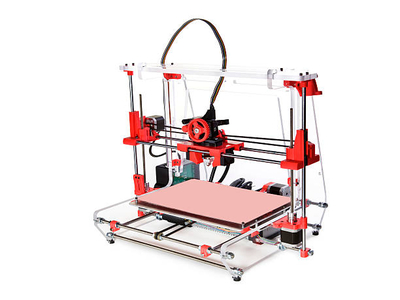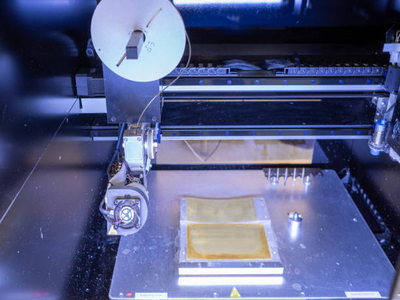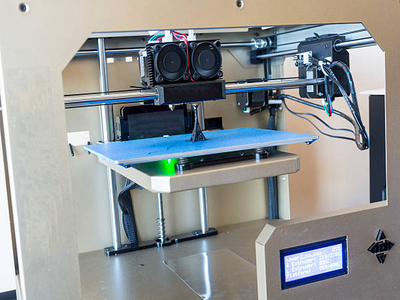Before we dive into how to clean a 3D printer bed, we need to first look at what causes a 3D printer to fail.
A common problem is when a print separates from the print bed. Maintaining adequate bed adhesion is critical to successful printing.
And one of the easiest ways to guarantee that your prints stay in place is to keep the print bed clean.
We’ll cover how to clean a 3D printer bed to improve adhesion and the look of your prints!
How to Clean a 3D Printer Bed
In the following sections, we’ll cover the most effective ways to keep the print bed clean and how to clean common bed adhesives like PEI, glass, and tape.
We recommend removing your bed from the printer (if possible) before cleaning.
PEI Sheet

PEI (polyetheretherimide) sheets are becoming increasingly popular because they have a firm grasp on a wide range of materials and readily release most prints when cold.
Clean The Surface Regularly
To provide optimum sticking, the surface must be cleaned regularly because the oil left on the surface by frequent contact lowers its grip.
A scratch or two can also damage the surface and reduce its adhesion.
Fortunately, regular cleaning and maintenance will ensure that your prints adhere firmly.
Before we discuss how to clean a PEI sheet, the video below covers when you should use PEI sheets over blue painters tape and how to use them for 3D printing jobs:
Read More: DIY 3D Printer Bed Leveling. We show you how to level your printer bed!
How To Clean PEI Sheet
To clean your PEI sheet, we recommend an unscented IPA in a concentration of 70% or above.
Wait until the bed is cool before wiping it with a cloth or paper towel soaked in IPA. The major portion of debris will be removed this way.
Using Acetone
Acetone is an excellent solution for removing any remaining plastic from the bed.
Simply use a cloth to dampen the sheet with acetone and carefully use the cloth to clean the surface of the bed.
When To Clean PEI Sheet
For optimum adhesion, most manufacturers recommend cleaning PEI sheets with IPA every few prints.
Eventually, though, cleaning your PEI sheet won’t do the trick and you’ll need to buy a new PEI sheet.
The frequency of these replacements depends on your printing volume and the sheet’s brand, although it can range from monthly to annually.
Glass

Printing on glass beds is best for creating a smooth, level surface over the bottom of a print.
How To Clean Glass
The simplest method to clean your glass bed is with a scraper.
It’s a good idea to heat the bed until the extra material is as soft to remove as much as possible.
Use the scraper to get rid of any residue.
Using Soap and Water
If scraping doesn’t work, try rubbing the glass with soap and warm water.
Keep in mind that this approach is only advised if you’re able to remove the bed from the printer.
Spilled water can wreak havoc on the machine’s heating unit, power supply, and other delicate components.
Using Cleaning Solutions
Cleaning solutions like alcohol pads, window spray, and high doses of IPA are all efficient at removing messes.
However, don’t use an excessively strong cleaning solution.
If you use a cleaning solution that is too strong, you might harm the bed, printer, or any other adhesives.
If you’re unsure, contact the manufacturer for the best cleaning methods for your printer.
Read More: How to Clean Printer Rollers. Here’s how to keep your printer rollers in good condition!
When To Clean Glass
We usually recommend scraping the bed after each print to eliminate any residue build-up.
When the printed object no longer adheres to the substrate (typically after about a month), try using soap and water to scrub.
After approximately 2 to 4 months of printing, you’ll most likely need to use IPA and other specialized cleaning solutions.
Adhesive Tape

Adhesive tape is popular among printers with non-heated beds.
The most popular types of tape include painter’s tape and masking tape, although Kapton and other tapes are also available.
How To Clean Adhesive Tape
Unfortunately, because adhesive tapes are so flimsy, they’re one of the most difficult to wipe clean.
Nonetheless, using a soft scraper is one of the most efficient methods to remove filament.
You should replace any damaged tape while cleaning as well.
The center of the bed is typically where holes form, due to the frequent removal of specific areas.
When patching the bed, don’t apply too many layers, as this might cause the surface of the bed to be uneven.
Read More: 3D Printing Positives and Negatives. Here’s what we love (and don’t love so much) about 3D printing!
When To Clean Adhesive Tape
Because of its fragility, the adhesive tape will have to be replaced more often than other adhesives, like PEI or buildtak sheets.
We usually advise lightly scraping the bed after each print to remove any filament.
Depending on the volume of prints you do, the bed might require resurfacing on a daily, weekly, or monthly basis.